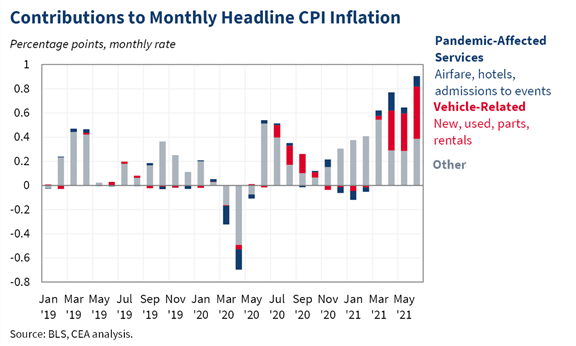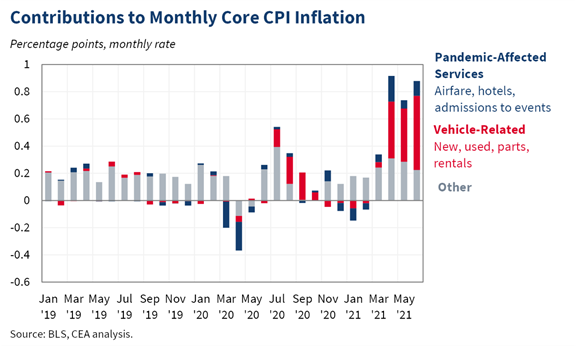
Today’s report shows that growth in the U.S. economy functionally held steady for the second quarter in a row at a strong pace. The United States economy grew at 6.5 percent at an annual rate in the second quarter of 2021. 1/ 

The level of real GDP is finally above its pre-pandemic level as the economy has experienced its fastest growth in the first half of the year since 1984. 2/ 

As consumers increasingly bought services, consumption of services contributed 5.1 percentage points to GDP. This is the most service consumption has ever contributed to GDP, except for the pandemic bounce back in 2020Q3. 3/ 

Real GDP is still around 2 percent lower than it would have been if it had continued growing at a 2 percent annual rate during the pandemic period. 4/
Real final sales to private domestic purchasers, which removes inventories, net exports, and government, and is less volatile than headline GDP, rose by 9.9 percent annualized in the second quarter, down from 11.8 percent annualized in the first quarter. 5/
GDP growth came in below earlier market expectations. To look at what may have impacted this number, we can use the @AtlantaFed GDPNow “now-cast” to determine how different components of GDP performed relative to one forecast’s projections. 6/ 

Note that the @AtlantaFed “now-cast,” which uses the most up-to-date data to estimate real GDP growth based on available economic data for the current measured quarter, was for 6.4 percent. 7/
Note that this “now-cast” was revised down yesterday largely in private inventories. In fact, faster inventory drawdowns, likely reflecting pandemic-related supply constraints, shaved 1.1 ppts off of GDP growth. 8/
It is always difficult to forecast, but it is particularly difficult at the moment given the unpredictability of the pandemic economy, as CEA discussed in a previous blogpost: 9/ whitehouse.gov/cea/blog/2021/… 

While the @AtlantaFed “now-cast” should not be considered “better” than other forecasters, it is useful because it incorporates the most recent data in order to provide a breakdown of the components of GDP, which not all forecasts do. 10/
Relative to the “now-cast”, government’s contribution to GDP underperformed considerably in the second quarter, as government subtracted almost 0.3 percentage point from GDP, compared to their expectation of over 0.8 percentage point 11/
Government spending was impacted by fewer banks being paid to process and administer Paycheck Protection Program (PPP) loans 12/
On the other hand, consumer spending, nonresidential investment, and net exports all performed better than the @AtlantaFed “now-cast” predicted. 13/
We know that the recovery from the pandemic will not be linear. The Council of Economic Advisers will continue to monitor the data as they come in. /end
• • •
Missing some Tweet in this thread? You can try to
force a refresh








